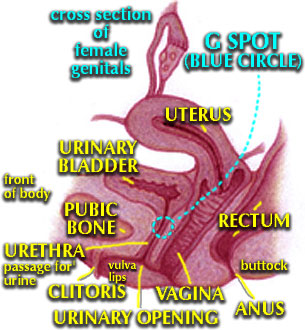

The Gräfenberg Spot (G-Spot)
Dr. Nelson Soucasaux, Brazilian Gynecologist
The Gräfenberg Spot - the G-spot - remains one of the most mysterious
subjects in the study of the female sexual response at the genital level.
The question of the existence or the non-existence of the G-spot in, at
least, some women, is a highly controversial subject which, unfortunately,
has not received the deserved attention on the part of gynecology. One of
the most interesting studies about it can be found in the book "Eve's
Secrets - A New Theory of Female Sexuality," by Josephine Lowndes
Sevely (Random House, Inc., New York, 1987). According to some anatomical
studies, the G-spot seems to correspond to a part of the female urethra
with many periurethral glands - glands around
the urethra (see the drawing, below) -, erectile tissue (tissue that swells)
and nerve endings responsive to sexual stimulation.
Periurethral glands can be usually found in the female urethra. These
glands are situated along the urethral canal and release their mucous into
its interior through very small ducts that open there. There are also the
two widely known Skene's, or paraurethral, glands, that open directly into
the vulva (the outer, visible parts of the female genitals), near the urethral
opening. The erectile tissue is made of a kind of blood vessel capable of
great expansion during sexual excitement, becoming exceptionally enlarged
and tense. In women, there is a great quantity of erectile tissue in the
clitoris, inside the labia majora and minora (the "lips" of the
vulva that cover the vaginal and urinary openings), around the vulvo-vaginal
opening and the lower third of the vagina. A very small quantity of this
tissue can also be found in the vaginal walls and along the urethra.
According to some studies, in the part of the female urethra corresponding
to the G-spot there would be a greater than usual amount of the already
mentioned periurethral glands and erectile tissue, together with many nerve
endings sensitive to sexual stimulation. The G-spot would be situated behind
the anterior (front) wall of the vagina, along the urethral canal and, when
stimulated, it would become swollen and able to trigger the orgasmic response.
If you insert a finger into the vagina, some reports
say, and press its front wall next to the urethra, the G-spot could not
only be stimulated, but also touched if engorged enough as a result of the
stimulation.

Nevertheless, despite several reports and some well-conducted studies,
the existence of the G-spot remains a very controversial subject. It's possible
that it can be only present (or fully developed) in a relatively small number
of women. The female periurethral glands seem to correspond to atrophic
embryonic remnants of the structure that originates the prostate gland in
men.
A few reports state that some women - those perhaps endowed with a highly
developed G-spot - produce a secretion by these periurethral glands during
orgasm. This secretion would be the even more mysterious and usually denied
"female ejaculation." Nevertheless,
such cases seem to be very rare and difficult to prove. The great problem
here is to establish the difference between this "mysterious"
secretion and the normal vaginal lubrication resulting from sexual excitement
and occasional release of urine during the orgasm.
I want to emphasize that all of this is still highly controversial and,
therefore, it is not my intention here to take any personal position on
the matter. I only hope that gynecology finally decides to investigate the
subject with the attention it deserves.
Copyright Nelson Soucasaux 2001 (text and illustration)
_____________________________________
Nelson Soucasaux is a gynecologist dedicated to clinical, preventive
and psychosomatic gynecology. Graduated in 1974 by Faculdade de Medicina
da Universidade Federal do Rio de Janeiro, he is the author of several articles
published in medical journals and of the books "Novas Perspectivas
em Ginecologia" ("New Perspectives in Gynecology") and "Os
Órgãos Sexuais Femininos: Forma, Função, Símbolo
e Arquétipo" ("The Female Sexual Organs: Shape, Function,
Symbol and Archetype"), published by Imago Editora, Rio de Janeiro,
1990, 1993.
Web site (Portuguese-English): http://www.nelsonginecologia.med.br
Email: nelsons@nelsonginecologia.med.br




